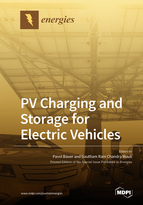PV Charging and Storage for Electric Vehicles
A special issue of Energies (ISSN 1996-1073). This special issue belongs to the section "E: Electric Vehicles".
Deadline for manuscript submissions: closed (20 August 2020) | Viewed by 50093
Special Issue Editors
Interests: power grids; electric vehicle charging; photovoltaic power systems; power convertors; battery powered vehicles; DC-DC power convertors; HVDC power convertors; distributed power generation; inductive power transmission; AC-DC power convertors; distribution networks; solar power stations; HVDC power transmission; load flow control; optimisation; power generation control; power system stability; pricing; secondary cells; voltage control; voltage-source convertors; arcs (electric) ; battery chargers; battery storage plants; building integrated photovoltaics
Special Issues, Collections and Topics in MDPI journals
Interests: electric vehicles; EV charging; power electronics; PV system; power management
Special Issue Information
Dear Colleagues,
Two major trends in energy usage that are expected for the future are the increase in distributed renewable generation like solar energy and the emergence of electric vehicles (EV) as the future mode of transportation. At the same time, there are many challenges for the integration of these two technologies. Firstly, electric vehicles are only ‘green’ as long as the source of electricity is ‘green’ as well. Secondly, photovoltaic (PV) power production suffers from diurnal and seasonal variations, creating the need for energy storage technology. Thirdly, overloading and voltage problems are expected in the distributed network due to high penetration of distributed generation and increased power demand from the charging of electric vehicles.
To overcome the above challenges, charging electric vehicles using distributed solar energy would be an excellent solution, resulting in net-zero emissions. Through vehicle-to-grid (V2G) and vehicle-to-home/building (V2H/V2B), the EV can be used as storage for PV and support the grid via ancillary services. With on-board solar panels, the driving range of electric cars can be increased by several km per day. Finally, intelligent control techniques combined with communication protocols can facilitate the intelligent charging of electric vehicles and offer of V2G services based on solar generations, grid congestion, and energy prices. Finally, in places with a lack of grid access, solar-powered charging can be the key enabler for the electrification of transportation.
The energy and mobility transition calls for novel technological innovations in the field of sustainable electric mobility powered from renewable energy. This Special Issue focuses on recent advances in technology for PV charging and storage for electric vehicles and includes, but is not limited to, the following topics:
- Power electronic converter for (DC) charging of EVs from solar (with bidirectional capability to feed energy back to the grid);
- Investigation of the synergy between solar electricity generation and EV charging demand;
- Innovative design of electric vehicles with on-board solar power for increased driving range;
- Intelligent systems for off-grid (stand-alone) solar charging of EVs;
- Power management techniques for solar EV systems to reduce grid congestion, increase solar self-consumption, reduce energy costs, and increase grid stability;
- Optimal sizing, location, and control of energy storage to manage diurnal and seasonal solar variations in order to meet EV charging requirements;
- Charging electric vehicles from solar energy in microgrids;
- Recent developments in ICT protocols for solar-powered smart charging of EVs (with V2G);
- Novel solar-powered contactless EV charging system (with bidirectional power capability to feed energy back to the grid);
- Solar-powered electrified public transportation (e.g., trams, buses, trains);
- Using the EV as energy storage for PV via Vehicle-to-X (e.g., V2G, V2H, V2B, V2L);
- State-of-the-art reviews on solar charging of EVs.
Prof. Dr. Pavol Bauer
Prof. Gautham Ram Chandra Mouli
Guest Editors
Manuscript Submission Information
Manuscripts should be submitted online at www.mdpi.com by registering and logging in to this website. Once you are registered, click here to go to the submission form. Manuscripts can be submitted until the deadline. All submissions that pass pre-check are peer-reviewed. Accepted papers will be published continuously in the journal (as soon as accepted) and will be listed together on the special issue website. Research articles, review articles as well as short communications are invited. For planned papers, a title and short abstract (about 100 words) can be sent to the Editorial Office for announcement on this website.
Submitted manuscripts should not have been published previously, nor be under consideration for publication elsewhere (except conference proceedings papers). All manuscripts are thoroughly refereed through a single-blind peer-review process. A guide for authors and other relevant information for submission of manuscripts is available on the Instructions for Authors page. Energies is an international peer-reviewed open access semimonthly journal published by MDPI.
Please visit the Instructions for Authors page before submitting a manuscript. The Article Processing Charge (APC) for publication in this open access journal is 2600 CHF (Swiss Francs). Submitted papers should be well formatted and use good English. Authors may use MDPI's English editing service prior to publication or during author revisions.
Keywords
- Energy storage
- Electric vehicle
- Power electronics
- Energy management systems
- Electric vehicles charging
- Solar energy
- Photovoltaic system
- V2G, V2H, V2B, V2L
- Distributed energy resources
- Microgrid
- Smart grid







